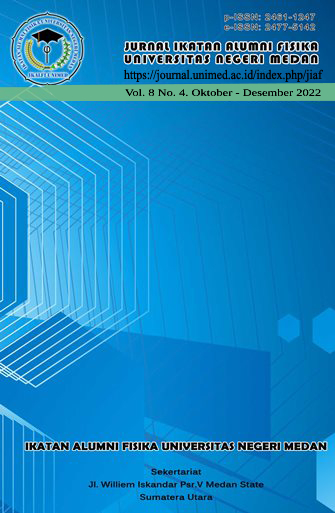Pengaruh Waktu Paparan UV terhadap Nilai Sudut Kontak Lapisan Polistiren(Ps)
DOI:
https://doi.org/10.24114/jiaf.v8i4.39653Keywords:
Polistiren, properti permukaan, radiasi UVAbstract
Polistiren(Ps) merupakan bahan polimer yang banyak digunakan untuk aplikasi sensor karena sifat viskoelastiknya. Permukaan lapisan Ps yang bersifat hidrofilik sangat diperlukan dalam aplikasi sensor untuk cairan. Permukaan yang bersifat hidrofilik dapat diperoleh dengan memodifikasi permukaan lapisan Ps menggunakan paparan sinar UV. Pada penelitian ini, waktu penyinaran UV yang digunakan adalah selama 30 menit, 60 menit, 90 menit, dan 120 menit. Variasi waktu penyinaran UV bertujuan untuk mengetahui perubahan sifat permukaan Ps. Hidrofilisitas polimer terkait dengan berat molekul dan polaritas polimer. Hal ini dapat dianalisis dengan menggunakan karakterisasi nilai sudut kontak lapisan Ps. Karakterisasi lapisan Ps setelah dipapari sinar UV dilakukan dengan menganalisis perubahan nilai sudut kontak. Berdasarkan percobaan yang telah dilakukan didapatkan bahwa semakin lama penyinaran UV menyebabkan semakin rendahnya nilai sudut kontak lapisan Ps. Nilai sudut kontak paling rendah yang dihasilkan adalah sebesar 55,801o ±0,0563o setelah dipapari sinar UV selama 120 menit.References
Avossa, Joshua et al. 2019. œElectrospinning of Polystyrene/Polyhydroxybutyrate Nanofibers Doped with Porphyrin and Graphene for Chemiresistor Gas Sensors. Nanomaterials 9(2).
Begum, Sabana Ara, Ajay Vasudeo Rane, and Krishnan Kanny. 2019. Compatibilization of Polymer Blends: Micro and Nano Scale Phase Morphologies, Interphase Characterization, and Properties Applications of Compatibilized Polymer Blends in Automobile Industry. Elsevier Inc. http://dx.doi.org/10.1016/B978-0-12-816006-0.00020-7.
Bhadra, Jolly et al. 2019. œFabrication of Polyaniline-Graphene/Polystyrene Nanocomposites for Flexible Gas Sensors. RSC Advances 9(22): 12496“506.
Jaganathan, Saravana Kumar et al. 2015. œReview: Radiation-Induced Surface Modification of Polymers for Biomaterial Application. Journal of Materials Science 50(5): 2007“18.
Mielczarski, J. A., Y. L. Jeyachandran, E. Mielczarski, and B. Rai. 2011. œModification of Polystyrene Surface in Aqueous Solutions. Journal of Colloid and Interface Science 362(2): 532“39. http://dx.doi.org/10.1016/j.jcis.2011.05.068.
Murakami, Takurou N. et al. 2003. œSurface Modification of Polystyrene and Poly(Methyl Methacrylate) by Active Oxygen Treatment. Colloids and Surfaces B: Biointerfaces 29(2“3): 171“79.
Sakti, Setyawan P., Layli Amaliya, Nike F. Khusnah, and Masruroh Masruroh. 2017. œEffect Of Uv Radiation Duration And Molecular Weight To Hydrophobicity And Surface Roughness Of Polystyrene Coating On QCM SENSOR. Jurnal Teknologi 79(3): 61“67. https://jurnalteknologi.utm.my/index.php/jurnalteknologi/article/view/9961.
Sakti, Setyawan P., and Putri S. Arinda. 2019. œEffect of the Polystyrene Surface Hydrophobicity on QCM Sensor Resonance Frequency in Contact with Water-Glycerol Mixture. Journal of Physics: Conference Series 1153(1).
Setiana, Mira, Tyas N. Zafirah, and Setyawan P. Sakti. 2020. œThe Response of QCM Sensor Coated with Polystyrene in Contact with Potassium Chloride Solution. Materials Today: Proceedings (xxxx). https://doi.org/10.1016/j.matpr.2020.11.443.
Shin, Joongmin, Xiaojing Liu, Naveen Chikthimmah, and Youn Suk Lee. 2016. œPolymer Surface Modification Using UV Treatment for Attachment of Natamycin and the Potential Applications for Conventional Food Cling Wrap (LDPE). Applied Surface Science 386: 276“84. http://dx.doi.org/10.1016/j.apsusc.2016.05.158.
Sikandar Shah, Syed, Imtiaz Ahmad, and Muhammad Ishaq. 2017. œDegradation Study of Used Polystyrene with UV Irradiation. Advanced Material Science 2(3).
Thormann, Esben, Adam C. Simonsen, Per L. Hansen, and Ole G. Mouritsen. 2008. œInteractions between a Polystyrene Particle and Hydrophilic and Hydrophobic Surfaces in Aqueous Solutions. Langmuir 24(14): 7278“84.
Weibel, Daniel Eduardo et al. 2009. œUltraviolet-Induced Surface Modification of Polyurethane Films in the Presence of Oxygen or Acrylic Acid Vapours. Thin Solid Films 517(18): 5489“95. http://dx.doi.org/10.1016/j.tsf.2009.03.204.
Yousif, Emad, and Raghad Haddad. 2013. œPhotodegradation and Photostabilization of Polymers, Especially Polystyrene: Review. SpringerPlus 2(1): 1“32.
Zhang, D, S M Dougal, and M S Yeganeh. 2000. œEffects of UV Irradiation and Plasma Treatment on a Polystyrene Surface Studied ¦. Langmuir (9): 4528“32. http://pubs.acs.org/doi/abs/10.1021/la991353i%5Cnpapers://0bb92f14-cf85-4889-8969-bc9f5c4a5634/Paper/p6863.
Downloads
Published
Issue
Section
License
Copyright (c) 2022 JURNAL IKATAN ALUMNI FISIKA UNIVERSITAS NEGERI MEDAN

This work is licensed under a Creative Commons Attribution 4.0 International License.
Authors who publish with this journal agree to the following terms:- Authors retain copyright and grant the journal right of first publication with the work simultaneously licensed under a Creative Commons Attribution License that allows others to share the work with an acknowledgement of the work's authorship and initial publication in this journal.
- Authors are able to enter into separate, additional contractual arrangements for the non-exclusive distribution of the journal's published version of the work (e.g., post it to an institutional repository or publish it in a book), with an acknowledgement of its initial publication in this journal.
- Authors are permitted and encouraged to post their work online (e.g., in institutional repositories or on their website) prior to and during the submission process, as it can lead to productive exchanges, as well as earlier and greater citation of published work (See The Effect of Open Access).

